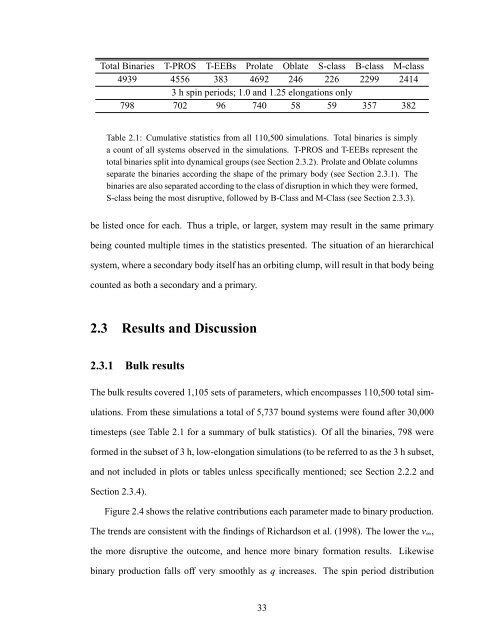Forming Binary Near-Earth Asteroids From Tidal Disruptions
Forming Binary Near-Earth Asteroids From Tidal Disruptions
Forming Binary Near-Earth Asteroids From Tidal Disruptions
You also want an ePaper? Increase the reach of your titles
YUMPU automatically turns print PDFs into web optimized ePapers that Google loves.
Total Binaries T-PROS T-EEBs Prolate Oblate S-class B-class M-class4939 4556 383 4692 246 226 2299 24143 h spin periods; 1.0 and 1.25 elongations only798 702 96 740 58 59 357 382Table 2.1: Cumulative statistics from all 110,500 simulations. Total binaries is simplya count of all systems observed in the simulations. T-PROS and T-EEBs represent thetotal binaries split into dynamical groups (see Section 2.3.2). Prolate and Oblate columnsseparate the binaries according the shape of the primary body (see Section 2.3.1). Thebinaries are also separated according to the class of disruption in which they were formed,S-class being the most disruptive, followed by B-Class and M-Class (see Section 2.3.3).be listed once for each. Thus a triple, or larger, system may result in the same primarybeing counted multiple times in the statistics presented. The situation of an hierarchicalsystem, where a secondary body itself has an orbiting clump, will result in that body beingcounted as both a secondary and a primary.2.3 Results and Discussion2.3.1 Bulk resultsThe bulk results covered 1,105 sets of parameters, which encompasses 110,500 total simulations.<strong>From</strong> these simulations a total of 5,737 bound systems were found after 30,000timesteps (see Table 2.1 for a summary of bulk statistics). Of all the binaries, 798 wereformed in the subset of 3 h, low-elongation simulations (to be referred to as the 3 h subset,and not included in plots or tables unless specifically mentioned; see Section 2.2.2 andSection 2.3.4).Figure 2.4 shows the relative contributions each parameter made to binary production.The trends are consistent with the findings of Richardson et al. (1998). The lower the v ∞ ,the more disruptive the outcome, and hence more binary formation results. Likewisebinary production falls off very smoothly as q increases. The spin period distribution33












